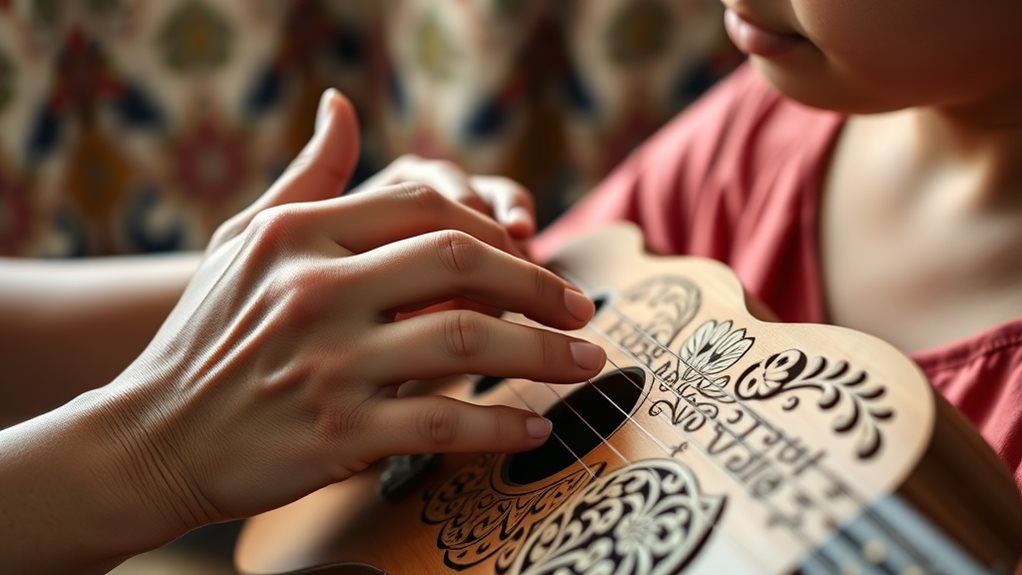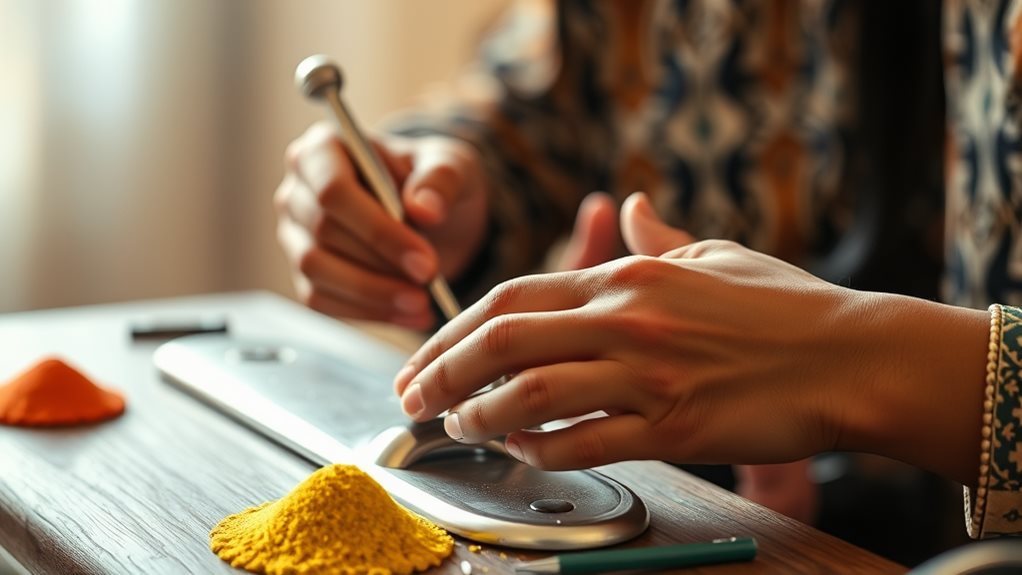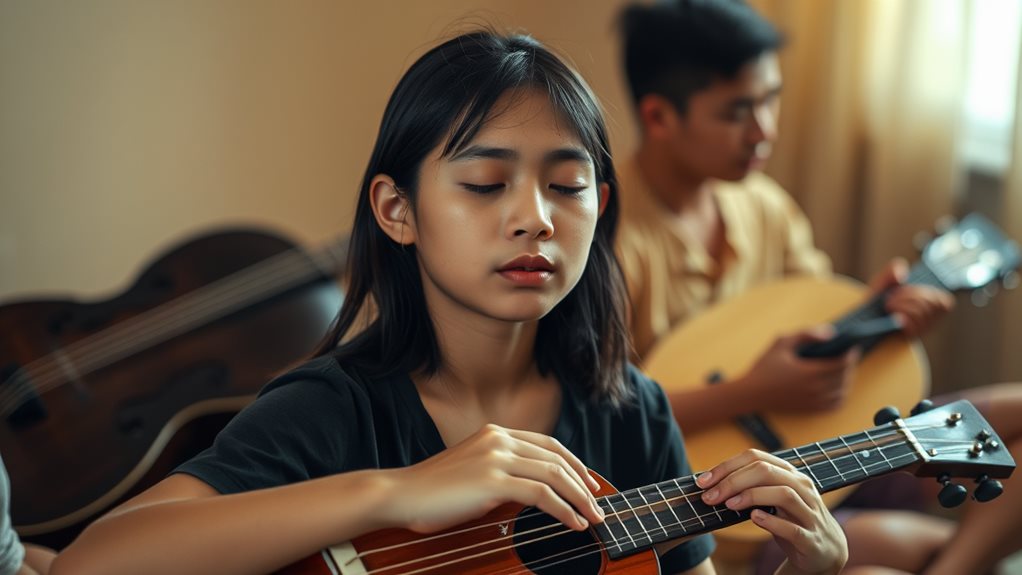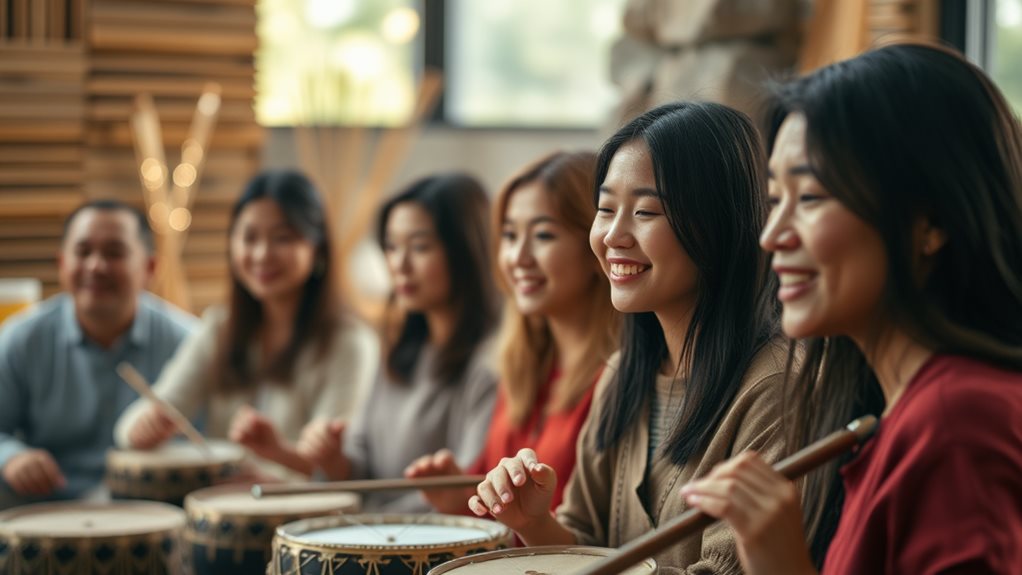Traditional Filipino music can be used in therapy to improve mental and physical well-being. This approach has been shown to reduce stress and anxiety, improve mood, and even manage chronic pain. For example, the familiar melodies of the "Kundiman" or "Harana" can connect individuals to their cultural identity and unlock pent-up emotions, promoting emotional release and healing.
Group sessions can build community and improve social interaction. In a group setting, participants can engage in activities such as playing traditional Filipino instruments, singing, or dancing together. This collective engagement can foster a sense of belonging and social connection, which is essential for overall well-being.
Personalized sessions can tailor music therapy to specific needs. In one-on-one sessions, a trained therapist can use traditional Filipino music to address individual needs, such as managing pain or improving cognitive function. For instance, a therapist might use the "Tinikling" rhythm to help a patient with motor skills rehabilitation.
The multisensory engagement of traditional Filipino music can enhance cognitive function and motor skills. By combining music, movement, and cultural expression, individuals can experience improved cognitive processing and motor control. This holistic approach can be particularly effective in healthcare settings, such as rehabilitation centers or hospitals.
Cultural Significance in Healing

Filipino music plays a significant role in healing, deeply rooted in the country's rich cultural heritage.
The Kulintang, a pre-colonial musical ensemble from southern Philippines, is an example of this. Passed down through generations, the indigenous gongs weren't just music but a conduit for spiritual connection. The rhythmic beats and melodic patterns facilitated communication with the spirit world, forming a crucial part of healing rituals.
Music is used for spiritual connection and healing in various Filipino cultures.
In Maguindanao culture, chanting is used in shamanic practices to summon spirits and aid healing processes. The Babaylan and Baylan, traditional Filipino shamans, also incorporated music into their rituals. For example, the Ata Manobo's oral chants, passed down through generations, demonstrate the link between music, cultural heritage, and spiritual healing.
These traditional practices are still maintained today through cultural regeneration initiatives.
The Tao Foundation for Culture and Arts spearheads such initiatives, demonstrating the enduring significance of music in Filipino society.
Modern perspectives on the therapeutic power of music have been shaped by these traditions, showcasing the interwoven nature of cultural heritage and spiritual connection in healing. The vibrations and frequencies of traditional music resonate not only with the physical body but also with the spirit, fostering a sense of well-being and deeper understanding of one's cultural identity.
Therapeutic Uses of Music
Music Therapy: A Wide-Ranging Therapeutic Tool****
Music therapy is a powerful tool that has numerous applications in managing various physical and mental health conditions. It can significantly reduce anxiety and stress levels, potentially surpassing the effects of some prescription medications. This is achieved through carefully designed music interventions that can be tailored to individual needs.
For instance, listening to music can lower stress hormones, while active music-making in therapy sessions, such as singing, playing instruments, or songwriting, can further alleviate stress.
Therapeutic Outcomes of Music Interventions
Research consistently shows that music interventions have a positive impact on therapeutic outcomes. Music therapy can improve mood, reduce pain perception, and better manage chronic conditions. Additionally, the physiological effects of music therapy are impressive, with potential benefits including lowered blood pressure, improved respiration, and increased overall relaxation.
Cognitive and Motor Benefits
Music therapy can also have a positive impact on cognitive function, particularly in individuals with neurodegenerative diseases. It can enhance motor skills and coordination, benefiting those with movement disorders. Furthermore, music-based interventions can be particularly beneficial for children and adolescents, helping to ease anxiety and improve emotional regulation.
Key to Sustained Benefits****
To experience sustained benefits from music therapy, consistent engagement with music-based interventions is essential. By incorporating music therapy into treatment plans, individuals can improve their overall well-being and quality of life.
Multisensory Engagement

Music therapy engages multiple senses, making it a unique therapeutic approach. This multisensory experience is particularly effective with Filipino music, which features diverse rhythms and melodies. For instance, traditional instruments like the kulintang and rondalla provide tactile stimulation and encourage sensory integration.
Playing musical instruments enhances motor coordination and develops fine motor skills. By actively participating in creating music, individuals improve their fine motor skills through instrument play and gross motor skills through dance. The vibrant colors and movements associated with some performances add a visual element, further enriching sensory integration.
The rhythmic nature of Filipino music naturally promotes motor coordination. This kinesthetic engagement is evident when people tap their foot, clap their hands, or sway to the beat. Such actions contribute to improved rhythmic skills and overall body awareness.
Music therapy is a fun and engaging way to improve motor coordination. It offers a tailored approach to refining both fine and gross motor control through carefully chosen instruments and exercises.
The multisensory nature of music therapy sessions aids in processing and integrating sensory input. This results in improved coordination and overall functional abilities. By providing a fun and engaging experience, music therapy helps individuals overcome challenges with motor coordination and develop their skills in a supportive environment.
Social Interaction Benefits
Social Interaction Benefits of Music Therapy Using Filipino Music****
Participating in group music therapy sessions using Filipino music improves social interaction and group dynamics. Engaging in activities like singing kundiman or playing traditional instruments like the kulintang fosters collaboration, encouraging turn-taking and active listening. This creates a supportive environment where individuals can comfortably interact with others, building confidence and reducing feelings of isolation.
The inherent rhythmic and melodic qualities of Filipino music provide a non-threatening avenue for self-expression. Filipino music helps bridge potential communication gaps by allowing individuals to communicate more effectively through nonverbal cues and expressions. This is particularly valuable for individuals with communication challenges. The shared experience of creating music together strengthens bonds and builds a sense of community.
Key benefits of music therapy using Filipino music include:
- Improved communication skills that extend beyond the therapy room, positively impacting daily interactions.
- Familiar melodies that help individuals feel more at ease during sessions, fostering a sense of belonging and safety.
- Opportunities to practice and improve social skills like sharing and collaboration in a group setting.
The structured yet flexible nature of group music therapy sessions, combined with the inherent social aspects of making music together, creates significant opportunities for personal and social growth. By participating in group music therapy sessions, individuals can learn to navigate group dynamics more effectively while enhancing their communication skills.
Emotional Expression

Music therapy using Filipino music is a powerful tool for emotional expression and healing. This approach utilizes familiar melodies and rhythms to create a strong emotional resonance, facilitating deeper self-understanding and tapping into one's personal musical identity. For instance, traditional Filipino songs like "Bahay Kubo" can evoke potent emotional responses, bypassing verbal barriers and allowing individuals to access feelings they might struggle to articulate otherwise.
Music therapy provides a unique outlet for emotional expression through a multi-sensory experience. This experience engages both auditory and visual senses, offering a safe space to explore complex emotions and address the stigma surrounding mental health. By using familiar songs to discuss personal experiences and challenges, individuals can experience a sense of validation and reduced feelings of isolation often associated with mental health struggles.
This approach is particularly beneficial for individuals with special needs and the elderly. Music therapy enables nonverbal communication and emotional processing, which can be especially helpful for individuals with communication difficulties. For example, children with communication difficulties may find solace and expression through music, while elderly individuals may experience enhanced memory and reduced anxiety.
Cultural music's ability to facilitate connection means that people from diverse backgrounds can find common ground and experience the healing power of shared musical identity and emotional resonance.
The therapeutic process allows individuals to tap into the power of music as a self-healing process. This process strengthens the connection to one's cultural identity, enriching emotional well-being and providing a profound impact on one's journey toward emotional healing.
Validation and Catharsis
Filipino Music Therapy Provides Validation and Catharsis****
Filipino music therapy is effective in providing validation and catharsis, primarily due to its ability to resonate deeply with patients and foster a strong emotional connection. Traditional Filipino music validates patients' cultural identity, which is particularly helpful when dealing with language barriers or patients suffering from dementia. The familiar melodies and rhythms offer a sense of comfort and recognition, easing communication difficulties. This cultural resonance strengthens the therapeutic relationship, building trust and encouraging openness.
The use of familiar songs can evoke surprisingly potent positive reactions, deepening the patient's sense of being seen and understood. For example, a patient with dementia may respond strongly to a traditional Filipino lullaby, evoking memories of their childhood and providing a sense of comfort and familiarity.
Catharsis is also a key element of Filipino music therapy. Traditional Filipino music can unlock pent-up emotions, providing a safe space for expression. Listening to or singing these songs acts as a conduit for emotional release, particularly beneficial for those struggling to verbalize their feelings. For instance, a patient struggling with grief may find solace in singing a traditional Filipino song that allows them to express their emotions in a healthy way.
The therapeutic power of Filipino music therapy also provides valuable insights into a patient's emotional state. The patient's response to familiar songs can reveal cues often missed through verbal interaction, such as a change in mood or a sudden emotional reaction. Utilizing specific songs can target particular memories or emotions, guiding patients toward self-discovery and understanding.
For example, a music therapist may use a traditional Filipino song to help a patient process a traumatic event, allowing them to work through their emotions in a safe and supportive environment.
Clinical Applications

Music therapy has diverse clinical applications in the Philippines. It's integrated into hospitals, clinics, and rehabilitation centers as part of broader multidisciplinary treatment plans. This approach reduces anxiety and depression symptoms, improves mood, enhances cognitive function, and decreases stress**** in patients.
Music therapy involves various activities, including singing, playing instruments, or composing music, tailored to individual needs. For instance, a patient may participate in singing traditional Filipino songs or playing instruments like the kulintang, a set of gongs.
The effectiveness of music therapy depends on the patient's overall health management. Active participation and commitment to health practices significantly enhance the therapy's long-term impact. This includes making deliberate decisions to improve psychological well-being and sustaining the positive effects of music therapy.
Incorporating traditional Filipino music into therapy creates a culturally relevant and resonant experience. This approach fosters engagement and enhances the therapeutic process** by leveraging the emotional power of familiar melodies. For example, a therapist might use the Tinikling, a traditional Filipino dance, to create a sense of cultural connection** and facilitate healing.
Ongoing research continually refines music therapy protocols to ensure the best possible outcomes in clinical settings.
Tailored Therapy Sessions
Tailored Music Therapy Sessions for Optimal Outcomes
Tailored music therapy sessions in the Philippines focus on individual needs, utilizing culturally relevant music and personalized song selections to achieve optimal therapeutic outcomes. By incorporating traditional Filipino songs, strong cultural connections are fostered, creating a sense of comfort and familiarity. This approach is particularly effective in bridging communication gaps with patients who've limited verbal abilities or cognitive impairments. As a result, improved relaxation and reduced anxiety are achieved through familiar melodies.
Collaborative Playlist Creation
Personalized playlists are created collaboratively with the patient, their family, and the music therapist. This process ensures the selected songs hold deep personal meaning, evoking cherished memories and emotions. The therapist actively listens and observes the patient's responses, adapting the session to their unique needs and preferences. By doing so, the music resonates deeply and enhances the therapeutic relationship****.
Therapeutic Music Selection
The selection of songs often includes traditional lullabies or popular songs from the patient's youth, strengthening cultural connections between the patient and their heritage. The therapist adapts the tempo, volume, and instrumentation of the music to suit the patient's current state and help them achieve their therapeutic goals. Carefully created playlists evoke a stronger emotional response to the music, deepening the effectiveness of the therapy.
The Therapeutic Process****
The therapeutic process utilizes music as a tool to facilitate communication, emotional expression, and memory recall. A supportive environment is created, where the patient's cultural heritage is valued and integrated into their healing journey. Through this personalized approach, music therapy becomes a powerful tool for improving overall well-being****.
Diverse Therapeutic Settings

The effectiveness of personalized music therapy extends across diverse settings, impacting patients' lives in various ways.
In hospice and palliative care, music therapy provides comfort during life's final stages**. Incorporating patients' favorite songs, like traditional Filipino tunes** such as "Harana," enhances the therapeutic effect. Family members can also participate in sessions to create a more personal experience. This approach helps bridge cultural and language barriers, particularly benefiting patients with dementia.
Music is a powerful tool in mental health treatment, alleviating stress, anxiety, and depression. Artists like Coeli San Luis use their music to combat stigma. Personalized playlists can elevate moods and positively impact behavior. Integrating music therapy into schools and community health centers makes it more accessible to a wider population. Incorporating various genres creates a more inclusive environment.
For individuals with intellectual disabilities, music therapy improves speech, motor skills, and social interaction. Multi-sensory experiences engage students effectively, while non-verbal communication through music benefits those with limited verbal skills.
Group settings foster collaboration and promote community integration. This integration is seen in events that raise awareness and funds for mental health causes.
Questions and Answers
What Instruments Are Commonly Used?
Traditional instruments are commonly used in therapy.
You'll find traditional instruments like the kulintang (a set of eight gongs) and rondalla (a string ensemble) frequently used in therapeutic settings. Their cultural significance enhances therapeutic benefits. Specifically, the kulintang's melodic sounds and the rondalla's harmony stimulate emotional responses, impacting patients' emotional and cognitive well-being.
How Much Does Music Therapy Cost?
The cost of music therapy sessions varies. Individual sessions typically cost between $50 and $120. Group sessions are often less expensive.
Insurance coverage for music therapy sessions is not uniform. It varies depending on the insurance provider and policy. As a result, it's essential to check with your insurance provider to determine the extent of coverage.
The frequency of sessions also impacts the overall cost. More frequent sessions will increase the total cost, while less frequent sessions will reduce it. When considering music therapy, it's crucial to factor in both the cost per session and the frequency of sessions to determine the best fit for your budget.
Are There Any Age Restrictions?
No age restrictions apply to music therapy. This form of therapy offers benefits across various age groups. Research has shown that music therapy can enhance emotional well-being in individuals of all ages. For example, music therapy has been used to help children with developmental disabilities, while also providing comfort and relaxation to older adults dealing with dementia. Additionally, music therapy promotes cultural relevance by incorporating music from different cultures and genres, making it accessible to people from diverse backgrounds.
How Long Are Typical Sessions?
Typical sessions last between 15 minutes and two hours. Session length is determined by individual needs and desired therapeutic benefits. Short sessions, typically 15-30 minutes, are used to focus on specific goals, allowing for concise and targeted work. Longer sessions, ranging from 45 minutes to two hours, enable deeper therapeutic work, providing more time for exploration and self-discovery.
Where Can I Find a Qualified Therapist?
Finding a qualified therapist can be done through various channels. Professional associations, such as the American Psychological Association (APA) or the National Association of Social Workers (NASW), often have directories that list licensed therapists in your area.
You can also search online directories, like Psychology Today or GoodTherapy, which allow you to filter therapists based on location, insurance, and areas of specialty. These directories often include therapist profiles, which can give you an idea of their qualifications and experience.
Additionally, you can check with institutions, such as hospitals or universities, to find therapists who are affiliated with these organizations. Many institutions have mental health departments that offer therapy services.
When searching for a therapist, it's essential to confirm their qualifications by checking their licensure and credentials. You can also read reviews from previous clients to get an idea of their experience and effectiveness.